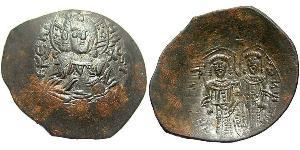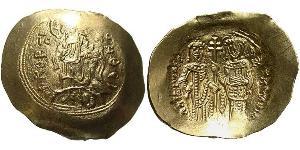|
|
This article includes a list of references, but its sources remain unclear because it has insufficient inline citations. (December 2008) |
| Alexios III Angelos Αλέξιος Γ’ Άγγελος |
|
|---|---|
| Emperor of the Byzantine Empire | |

Alexios III from
Promptuarii Iconum Insigniorum
|
|
| Reign | 1195–1203 |
| Predecessor | Isaac II Angelos |
| Successor | Isaac II Angelos and Alexios IV Angelos |
| Spouse | Euphrosyne Doukaina Kamatera |
| Issue | Eirine Angelina Anna Komnene Angelina Eudokia Angelina |
| Dynasty | Angelos dynasty |
| Father | Andronikos Dukas Angelos |
| Mother | Euphrosyne Kastamonitissa |
| Born | c. 1153 |
| Died | 1211 |
Alexios III Angelos (Greek: Αλέξιος Γ' Άγγελος) (c. 1153–1211) was Byzantine Emperor from 1195 to 1203. A member of the extended Imperial family, Alexios came to throne after deposing his brother in 1195. The most significant event of his reign was the attack of the Fourth Crusade on Constantinople in 1203, on behalf of Alexios IV Angelos. Alexios III took over the defence of the city, which he mismanaged, then fled the city at night with one of his three daughters. From Adrianople, and then Mosynopolis, he unsuccessfully attempted to rally his supporters, only to end up a captive of Marquis Boniface of Montferrat. He was ransomed, sent to Asia Minor where he plotted against his son-in-law Theodore Laskaris, but was eventually arrested and spent his last days confined to the Monastery of Hyakinthos in Nicaea, where he died.
Early life[edit]
Alexios III Angelos was the second son of Andronikos Doukas Angelos and Euphrosyne Kastamonitissa. Andronikos was himself a son of Theodora Komnene Angelina, the youngest daughter of Emperor Alexios I Komnenos and Irene Doukaina. Thus Alexios Angelos was a member of the extended imperial family. Together with his father and brothers, Alexios had conspired against Emperor Andronikos I Komnenos (c. 1183), and thus he spent several years in exile in Muslim courts, including that of Saladin.
His younger brother Isaac was threatened with execution under orders of Andronikos I, their first-cousin once-removed, on September 11, 1185. Isaac made a desperate attack on the imperial agents and killed their leader Stephen Hagiochristophorites. He then took refuge in the church of Hagia Sophia and from there appealed to the populace. His actions provoked a riot, which resulted in the deposition of Andronikos I and the proclamation of Isaac as Emperor. Alexios was now closer to the imperial throne than ever before.
Reign[edit]
By 1190 Alexios had returned to the court of his younger brother, from whom he received the elevated title of sebastokratōr. In 1195, while Isaac II was away hunting in Thrace, Alexios was acclaimed as emperor by the troops with the covert support of Alexios' wife Euphrosyne Doukaina Kamatera. Alexios captured Isaac at Stagira in Macedonia, put out his eyes, and thenceforth kept him a close prisoner, despite having previously been redeemed by Alexios from captivity at Antioch and showered with honours.[1]
To compensate for this crime and to solidify his position as emperor, Alexios had to scatter money so lavishly as to empty his treasury, and to allow such licence to the officers of the army as to leave the Empire practically defenceless. These actions inevitably led to the financial ruin of the state. At Christmas 1196, Holy Roman Emperor Henry VI attempted to force Alexios to pay him a tribute of 5,000 pounds (later negotiated down to 1,600 pounds) of gold or face invasion. Alexios gathered the money by plundering imperial tombs at the church of the Holy Apostles and taxing the people heavily, though Henry's death in September 1197 meant the gold was never dispatched. The able and forceful empress Euphrosyne tried in vain to sustain his credit and his court; Vatatzes, the favourite instrument in her attempts at reform, was assassinated by the emperor's orders.[1]
In the east the Empire was overrun by the Seljuk Turks; from the north, the Kingdom of Hungary and the rebellious Bulgarians and Vlachs descended unchecked to ravage the Balkan provinces of the Empire, sometimes penetrating as far as Greece, while Alexios squandered the public treasure on his palaces and gardens and attempted to deal with the crisis through diplomatic means. The Emperor's attempts to bolster the empire's defences by special concessions to pronoiars (notables) in the frontier zone backfired, as the latter increased their regional autonomy. Byzantine authority survived, but in a much weakened state.
Fourth Crusade[edit]
Soon Alexios was threatened by a new and more formidable danger. In 1202, soldiers assembled at Venice to launch the Fourth Crusade. Alexios IV Angelos, the son of the deposed Isaac II, had recently escaped from Constantinople and now appealed for support to the crusaders, promising to end the schism of East and West, to pay for their transport, and to provide military support if they would help him depose his uncle and ascend to his father's throne.[1]
The crusaders, whose objective had been Egypt, were persuaded to set their course for Constantinople, arriving there in June 1203, proclaiming Alexios IV as Emperor, and inviting the populace of the capital to depose his uncle. Alexios III took no effective measures to resist, and his attempts to bribe the crusaders failed. His son-in-law, Theodore Laskaris, who was the only one to attempt anything significant, was defeated at Scutari, and the siege of Constantinople began. Unfortunately for the city, misgovernment by Alexios III had left the Byzantine navy with only 20 worm-eaten hulks by the time the crusaders arrived.
In July, the crusaders, led by the aged Doge Enrico Dandolo, scaled the walls and took control of a major section of the city. In the ensuing fighting, the crusaders set the city on fire, ultimately leaving 20,000 people homeless. On 17 July Alexios III finally took action and led 17 divisions from the St. Romanus Gate, vastly outnumbering the crusaders. His courage failed, however, and the Byzantine army returned to the city without a fight. His courtiers demanded action, and Alexios III promised to fight. Instead, that night (July 17/18), Alexios III hid in the palace, and finally, with one of his daughters, Eirene, and such treasure (1,000 pounds of gold) as he could collect, got into a boat and escaped to Debeltos in Thrace, leaving his wife and his other daughters behind. Isaac II, drawn from his prison and robed once more in the imperial purple, received his son, Alexios IV, in state.
Life in exile[edit]
Alexios III attempted to organize resistance to the new regime from Adrianople and then Mosynopolis, where he was joined by the later usurper Alexios V Doukas Mourtzouphlos in April 1204, after the definitive fall of Constantinople to the crusaders and the establishment of the Latin Empire. At first Alexios III received Alexios V well, even allowing him to marry his daughter Eudokia Angelina. Later Alexios V was blinded and deserted by his father-in-law, who fled from the crusaders into Thessaly. Here Alexios III eventually surrendered, with Euphrosyne, to Marquis Boniface of Montferrat, who was establishing himself as ruler of the Kingdom of Thessalonica.
Alexios III attempted to escape Boniface's "protection" in 1205, seeking shelter with Michael I Komnenos Doukas, the ruler of Epirus. Captured by Boniface, Alexios and his retinue were sent to Montferrat before being brought back to Thessalonica in c. 1209. At that point the deposed emperor was ransomed by Michael I, who sent him to Asia Minor, where Alexios' son-in-law Theodore Laskaris - now emperor of Nicaea - was holding his own against the Latins. Here Alexios conspired against his son-in-law after the latter refused to recognize Alexios' authority, receiving the support of Kaykhusraw I, the sultan of Rûm. In the Battle of Antioch on the Meander in 1211, the sultan was defeated and killed, and Alexios was captured by Theodore Laskaris. Alexios was then confined to a monastery at Nicaea,[2] where he died later in 1211.
Family[edit]
By his marriage to Euphrosyne Doukaina Kamatera, Alexios had three daughters:
- Eirene Angelina, who married (1) Andronikos Kontostephanos, and (2) Alexios Palaiologos, by whom she was the grandmother of Emperor Michael VIII Palaiologos.
- Anna Angelina, who married (1) the sebastokratōr Isaac Komnenos, great-nephew of emperor Manuel I Komnenos, and (2) Theodore Laskaris, emperor of Nicaea.
- Eudokia Angelina, who married (1) Serbian King Stefan Nemanjić, then (2) Emperor Alexios V Doukas, and (3) Leo Sgouros, ruler of Corinth.
Notes[edit]
- ^ a b c Chisholm 1911.
- ^ Warren T. Treadgold, A History of the Byzantine State and Society, (Stanford University Press, 1997), 717.
References[edit]
 This article incorporates text from a publication now in the public domain: Bury, John Bagnell (1911). "Alexius III". In Chisholm, Hugh. Encyclopædia Britannica 1 (11th ed.). Cambridge University Press.
This article incorporates text from a publication now in the public domain: Bury, John Bagnell (1911). "Alexius III". In Chisholm, Hugh. Encyclopædia Britannica 1 (11th ed.). Cambridge University Press.- Michael Angold, The Byzantine Empire, 1025–1204: A Political History, second edition (London and New York, 1997)
- C.M. Brand, Byzantium Confronts the West (Cambridge, MA, 1968)
- Jonathan Harris, Byzantium and the Crusades, (2nd ed. London and New York, 2014). ISBN 978-1-78093-767-0
- Jonathan Harris, Constantinople: Capital of Byzantium (London and New York, 2007)
- The Oxford Dictionary of Byzantium (Oxford, 1991), 3 vols.
- K. Varzos, Ē genealogia tōn Komnēnōn (Thessalonica, 1984)
- Plate, William (1867). "Alexios III Angelos". In William Smith. Dictionary of Greek and Roman Biography and Mythology 1. Boston: Little, Brown and Company. p. 130.
|
Alexios III Angelos
Angelid dynasty
Born: 1153 Died: 1211 |
||
| Regnal titles | ||
|---|---|---|
| Preceded by Isaac II Angelos |
Byzantine Emperor 1195–1203 |
Succeeded by Isaac II Angelos |
| Succeeded by Alexios IV Angelos |
||






